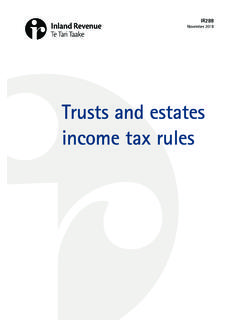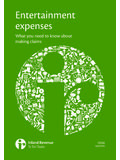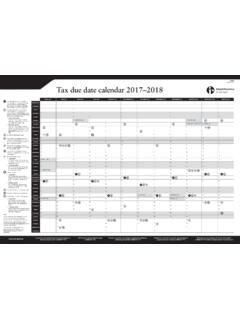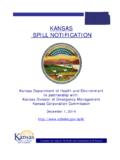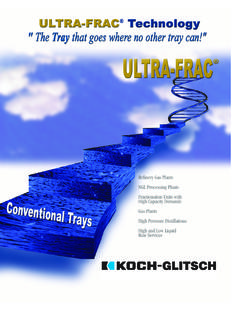Transcription of KiwiSaver employer guide - Inland Revenue
1 KS4 April 2018 KiwiSaver employer guideWhat employers need to know about KiwiSaverWHAT IS KiwiSaver ? KiwiSaver is a voluntary, work-based savings initiative designed to make regular saving for retirement easier for New new employee can opt out by giving you or Inland Revenue a New employee opt-out request (KS10) form. Send the KS10 and the KS1 forms to Inland RevenueSee page 20 New employee(s) start at your business (existing employees can also join)Existing employees see page 10 Exempt employers see page 26 Give them a KiwiSaver employee information pack supplied by Inland Revenue if they meet the criteria for automatic enrolment, if they re considering opting in or if they ask for oneAutomatic enrolment see page 8 KiwiSaver information pack see page 18 You can view copies of all our forms and guides by going to and selecting All forms and guides from the right-hand menu, or by entering the shoulder number in the search box.
2 You can also order copies by calling 0800 257 overview of your KiwiSaver responsibilities as an employerEmployees or Inland Revenue can ask you to stop KiwiSaver deductions by showing you a contributions holiday notice from Inland RevenueSee page 21If the employee opts out, you must stop making deductions and you can refund any KiwiSaver contributions you hold that haven t been sent to Inland Revenue . employer contributions you ve made will be refunded to you. Late opt-outs operate slightly differentlyEmployee stays in KiwiSaver New employee opts outEmployee gives you their details, including IRD number, name and address. Send this information to Inland Revenue using the New employee details (KS1) automatically enrol new employee(s) and start deducting from the employee s first pay, or start deducting for employees that opted in. If the employee is eligible, you must also make compulsory employer contributions on behalf of your employeePay KiwiSaver contributions to Inland Revenue with your PAYE payments.
3 Please send the New employee details (KS1) form to Inland Revenue before your employer monthly schedule (EMS/IR348) if possibleInland Revenue passes contributions to your employee s scheme providerClassified Inland Revenue - PublicContentsHow KiwiSaver works 2 Enrolment 4 Who can join KiwiSaver ? 4 New employees 7 Are they eligible? 9 Existing employees 10 Member contributions 11 employer contributions 14 General administration 17 KiwiSaver forms and the KiwiSaver employee information pack 18 Completing the employer deductions (IR345) form 19 Requests to opt out 20 Contributions holidays 21 Deductions from accident compensation payments 22 Parental leave payments 22 Contributions made in error 22 Payroll subsidy 22 Record keeping 23 Obligations and compliance 23 Penalties and interest 24 Your options as an employer 25 employer -chosen schemes 25 Existing workplace schemes 26 Additional information 27 Glossary 28 Quick reference guide 31 Answering employees KiwiSaver questions 32 About this guideThis guide tells you about your KiwiSaver obligations as an employer .
4 The KiwiSaver Act 2006 covers employers who are New Zealand residents or who carry on business from a fixed establishment in New Zealand. employers who are not New Zealand residents or do not carry on business from a fixed establishment in New Zealand, may choose whether they offer KiwiSaver in their workplace. A non-resident employer may choose to make KiwiSaver deductions and contributions for their eligible employees. Non-resident employers who are intending to participate in KiwiSaver and who are not registered for PAYE should contact Inland Revenue for more can find further information about employer obligations for complying funds1 at also see the KiwiSaver employee information pack for more general A complying superannuation fund (complying fund) is a section of registered superannuation schemes that have been approved by the Financial Markets Authority as having met certain criteria similar to KiwiSaver (eg, KiwiSaver lock-in rules and portability).
5 Classified Inland Revenue - Public2 KiwiSaver employer GUIDEHow KiwiSaver worksInland Revenue administers KiwiSaverKiwiSaver is a voluntary savings initiative designed to make it easier for New Zealanders to save for their future. For most people, KiwiSaver is work based. This means they receive information about KiwiSaver from you as their employer , and their KiwiSaver contributions come straight out of their pay. You are also required to contribute to your employee s savings in KiwiSaver schemes or complying are a number of membership benefits to encourage employees to save. These are set out in the KiwiSaver employee information is open to all New Zealand citizens and people entitled to be in New Zealand indefinitely who are under the age of eligibility for New Zealand Superannuation (currently 65). A person needs to be living (or normally living) in New Zealand to employeesYou must automatically enrol eligible new employees who are not already KiwiSaver members.
6 See page 9 to check if your new employee is eligible for automatic enrolment. Temporary and casual workers may be exempt from KiwiSaver automatic enrolment (see page 5).Make KiwiSaver deductions from the employee s first pay and continue unless they opt out. New employees who have been automatically enrolled in KiwiSaver can opt out any time on or after day 14 and on or before day 56 after starting their employment. Their contributions will be refunded. If your employee opts out, your employer contributions will be employeesExisting employees are not subject to automatic enrolment but, if eligible, they can choose to join KiwiSaver . They either sign up direct with the KiwiSaver scheme provider of their choice, or tell you they want to opt in. They will usually do this by giving you a KiwiSaver deduction form (KS2), which is in the KiwiSaver information pack. If you receive one of these, you need to determine if they are eligible to opt in (see page 4), and, if they are, send the information to Inland Revenue and start making member and compulsory employer contributions, if : If an existing employee opts in to KiwiSaver they can t opt contributionsFrom the first full pay period, starting on or after 1 April 2013, the minimum contribution rate for KiwiSaver employee contributions increased to 3%.
7 Employees can choose a contribution rate of either 3%, 4% or 8% of their gross salary or contributionsFrom the first full pay period starting on or after 1 April 2013 the compulsory employer contribution rate is 3% of your employee s gross salary or wages. Your contributions to existing superannuation schemes may reduce the amount of compulsory employer contributions you re required to pay, if they meet certain conditions (see page 16).All employer superannuation cash contributions ( employer contributions) to KiwiSaver and complying funds are liable for ESCT ( employer superannuation contribution tax). The exception to this is if the employee and employer have agreed to treat some or all of the employer contributions as salary or wages under the PAYE rules (see page 15).Classified Inland Revenue - PublicKIWISAVER employer GUIDE3 How contributions are collectedYou deduct KiwiSaver contributions from your employee s salary or wages and pay them to Inland Revenue with your PAYE payments.
8 You keep making deductions and employer contributions until your employee gives you a New employee opt-out request (KS10) form, contributions holiday notice, or Inland Revenue tells you to stop deducting contributions (see page 14). KiwiSaver member deductions and employer contributions are paid to Inland Revenue through the PAYE system. Inland Revenue forwards contributions to the member s chosen KiwiSaver scheme provider. If you pay compulsory employer contributions on behalf of employees who are members of complying funds, you pay these direct to the complying options as an employerThere are a number of options available if you would like to be more involved in encouraging retirement savings among your employees. These include making additional voluntary employer contributions and/or providing your own employer -based KiwiSaver scheme. You can also nominate a KiwiSaver scheme for your employees to join if they make no choice of their own.
9 This is called an employer -chosen scheme (see page 25).A note about providing financial adviceYou should not provide financial advice to employees. Instead, refer them to the Commission for Financial Literacy and Retirement Income s website or encourage them to talk to an independent financial advisor. You do not have any liability if you only provide general savings or KiwiSaver information or select an employer -chosen KiwiSaver contributions are investedEmployerSaver(Salary and wage earners)SavingsRetirement benefit paid to saverSavingsScheme provider(Savers can choose)Classified Inland Revenue - Public4 KiwiSaver employer GUIDEThis section sets out your responsibilities as an employer for enrolling employees in s importantYou are required to: check whether a new or existing employee is eligible to be a KiwiSaver member (see below) check whether the new employee should be automatically enrolled (see page 9) distribute the KiwiSaver information pack, which includes our factsheet Your introduction to KiwiSaver employee information (KS3), KiwiSaver deduction form (KS2) and the New employee opt-out request (KS10) form, to new employees who are subject to automatic enrolment, and to existing employees who are considering opting in or who ask for a KiwiSaver information pack provide new employees with a product disclosure statement if you have an employer -chosen KiwiSaver scheme and advise them they ll be allocated to this scheme unless they choose their own KiwiSaver scheme (see page 25)
10 Automatically enrol all new employees who are subject to automatic enrolment send us the details of new employees who are enrolled automatically in KiwiSaver using the New employee details (KS1) form. Please send us these details before your employer monthly schedule (EMS) is due, so that an account can be set up for the member s contributions before the EMS is can join KiwiSaver ? KiwiSaver is open to all New Zealand citizens and people entitled to live here permanently who are under the age of eligibility for New Zealand Superannuation (currently 65). Citizenship and residencyTo join KiwiSaver , a person must be living (or normally living) in New Zealand, and be a New Zealand citizen or entitled, under the Immigration Act 1987, to be in New Zealand indefinitely. This means New Zealand citizens, Australian citizens and people who hold either a New Zealand or Australian residence permit can join KiwiSaver .






